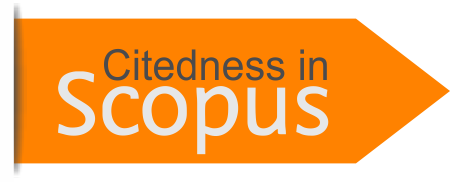Hospital Safety Box Monitoring: Building Brand Trust in Healthcare Business During Covid -19 Wave
Abstract
The health business is adjusting to a new reality where bargaining power has shifted to consumers. Consumers are now playing a key role in the commercialization process, making them important stakeholders to fulfill their needs. Health business reforms have convinced consumers to give protection a greater priority than ever since the COVID-19 pandemic escalated around the world. Health care businesses in Indonesia are no exception, should increase their brand trust, because of the huge responsibility to protect consumers from the prevention of COVID-19, and brand trust also gives added value to the hospital's own brand. A brand with the right value proposition can "prove" the true value of its product or service to patients in the minds of consumers, one of which is from medical waste management. Hospital waste is usually a contagious and toxic chemical that can affect human health and environmental impacts if not treated properly. Medical waste including sharp objects, infectious waste, pharmaceutical waste, and other waste is mostly generated in health facilities such as health centers and hospitals. such as intravenous lines, syringes, gloves, which after use must be handled and destroyed in such a way that they do not fall into the hands of the public or even injure medical personnel. The Smart Waste concept is here to answer the challenges of trust in hospital brands in Indonesia, especially in the city of Bandung, increasing the sense of security of consumers is the main goal of this concept where hospital safety boxes work together with sensors and microcontrollers, disposal of syringes can be done more intelligently. , safe and the risk of medical personnel punctured by infected needle waste can be reduced.
Keywords
Full Text:
PDFReferences
Agrawal, R., & Srikant, R. (1994). Fast algorithms for miningassociation rules, [C]//Bocca JB, Jarke M, Zaniolo C, eds.Proc. of the 20th Int’l Conf. on Very Large Data Bases.Santigo, Morgan Kaufman Publishers, 478-499.
Agrawal, R., Imielinski, T., & Swami, A. (1993). Mining association rules between sets of items in large databases, [C]//Buneman P, Jajodia S,eds. Proc. of the ACM SIGMOD Conf. on Management of Data (SIGMOD’93). New York: ACM Press, 207-216.
Chen, A. L., Tang, C. J., Tao, H. C., Yuan, C. A., & Xie, F. J. (2004). An improved algorithm based on maximum clique and FP-tree for mining association rules, Journal of Software, 15(8), 1198-1207.
Chen, C., Sun, Y., & Li, Z. (2009). Characteristic analysis of evolution and derivation chain of risk events caused by snow and ice disasters, Journal of Catastrophology, 3(1).
Cheng, Y., Ren, G., & Du, L. (2009). A priori based data mining technology for marine disaster forecast, Shandong Science, 2.
Ding, W. (2009). Response to emergencies and public crisis management, Guangming Daily Press.
Han, J., Pei, J., & Yin, Y. (2000). Mining frequent patterns withoutcandidate generation, [C]//Chen W D, Naughton J,Bernstein P A, eds. Proc. of the 2000 ACM SIGMOD Int’l Conf. on Management of Data (SIGMOD 2000).New York: ACM Press, 1-12.
He, S. (2009). Research on seismic reliability and optimum retrofit of water supply network system. Dalian University of Technology.
Hipp, J., Güntzer, U., & Nakhaeizadeh, G. (2000). Algorithms for association rule mining-A general survey and comparison. SigKDD Explorations, 2(1), 58-64.
Ji, L., Chi, H., & Chen, A. (2006). Emergency management, Higher Education Press.
Mannila, H., Toivonen, H., & Verkamo, A. (1997). Discovery of frequent episodes in event sequences, [C]//Katharina M,Hanna K eds. Data Mining and Knowledge Discovery 1. Netherlands: Kluwer Academic Pulishers, 259-289.
Mo, L. (2011). Aggravating concerning on food contamination and the price inflation of international food caused by nuclear leak, Financial Times, 3-29.
Shen, J. (2010). Discussion of the problems and counter measures about communication confusion at the disaster site, Fire Science, 4, 75-77.
Tian, Y. (2009). Study on tourism emergency associationrule mining algorithm, Beijing University of Posts and telecommunications.
Wang, S., Liu, T., Chen, S., & Zheng, G. (2010). Unexpected disasters on our country's economic influence and emergency management research, Science Press.
Xiao, B., Xu, Q. F., Lin, Z. Q., Guo, J., & Li, C. G. (2008). Credible association rule and its mining algorithm based on maximum clique, Journal of Software, 19(10), 2597-2610.
Xu, Q. F., Xiao, B., & Guo, J. (2007). A mining algorithm with alarm association rules based on statistical correlation, Journal of Beijing University of Posts and Telecommunications, 30(1), 66-70.
Xue, L., Zhang, Q., & Zhong, K. (2003). Crisis management in China the challenge of the transition, Tsinghua University Press.
Bernardo, S. C., Aiko, C. S., Bernardes, & Julia V. A. P. (2018). Artificial Intelligence in Automated Sorting in Trash Recycling, Researchgate.
Bernardo, S. C., Aiko, C. S., Bernardes, & Julia V. A. P. (2019). Artificial Intelligence in Automated Sorting in Trash Recycling, Researchgate.
Hiba, Z., Khalil, K., Roy, A. Z. D., Ali, H., & Josef, B. (2019). Smart Medicine Box System.Researchgate.
Mst. Shamima Hossain, BidyaDebnath, Adrita Anika, Md. Junaed-Al-Hossain, Sabyasachi Biswas, & Celia Shahnaz. (2019). Autonomous Trash Collector Based on Object.Researchgate.
Umut Özkaya & Levent Seyfi. (2018). Fine-Tuning Models Comparisons on Garbage Classification for Recycability.ISAS 2018.
DOI: https://doi.org/10.47194/ijgor.v2i1.64
Article Metrics
Abstract view : 352 timesPDF - 285 times
Refbacks
- There are currently no refbacks.
Copyright (c) 2021 International Journal of Global Operations Research

This work is licensed under a Creative Commons Attribution 4.0 International License.
Published By:Â
Iora Journal
Jl. Merkuri Timur VI No. 1, RT. 007, RW. 004, Manjahlega, Rancasari, Kota Bandung, Jawa Barat, INDONESIAÂ Phone: +62 85841953112; +62 811
IJGOR Indexed By:Â


 Â
 

 Â
  Â
Â
Â
Â
 This work is licensed under a Creative Commons Attribution 4.0 International License.
This work is licensed under a Creative Commons Attribution 4.0 International License.


